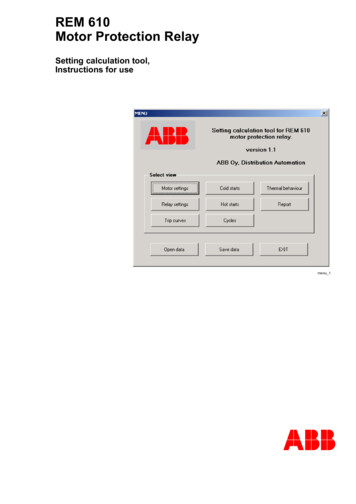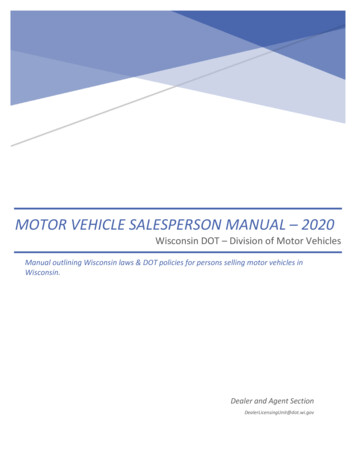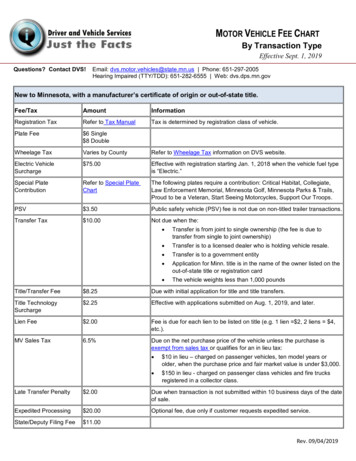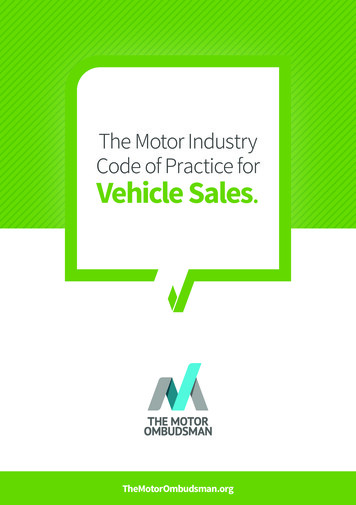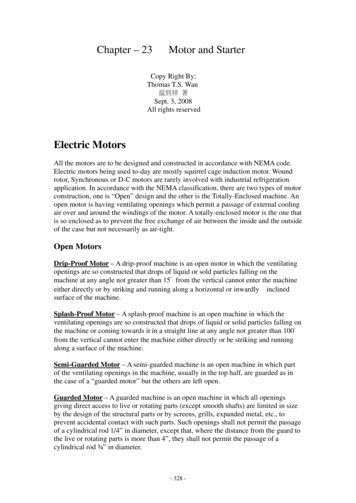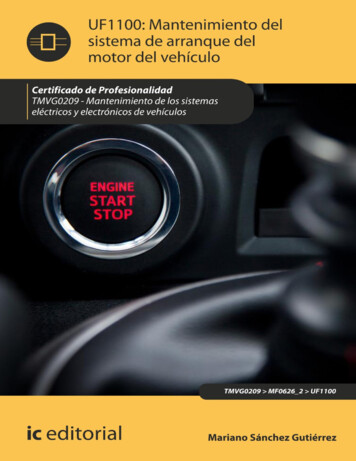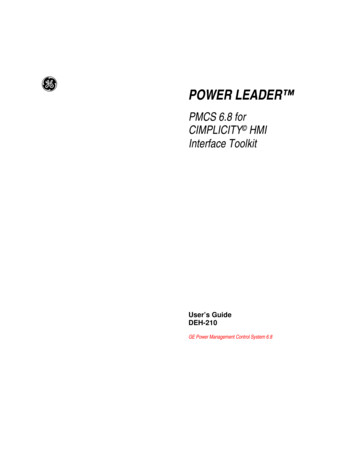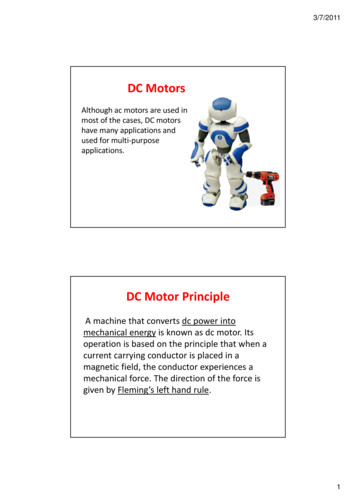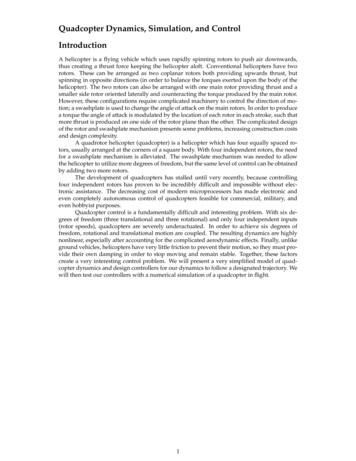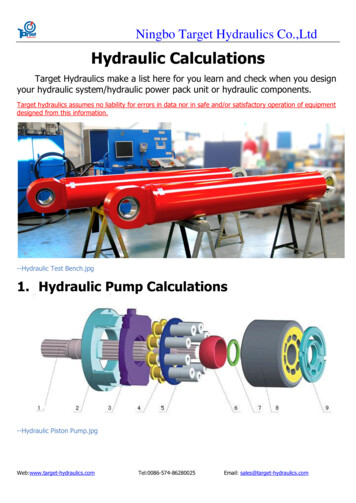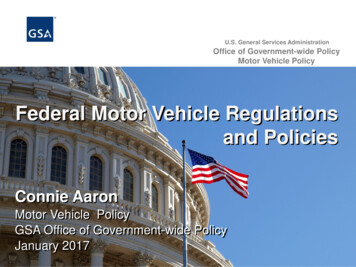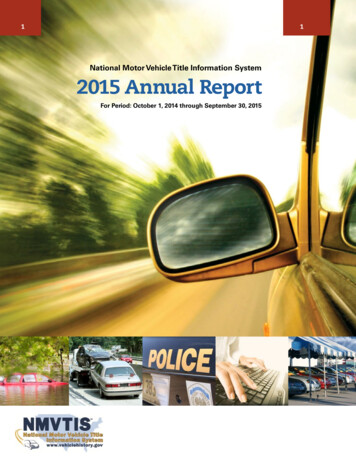
Transcription
11National Motor Vehicle Title Information System2015 Annual ReportFor Period: October 1, 2014 through September 30, 2015
This material is based upon work pursuant to a Cooperative Agreementbetween the U.S. Department of Justice/Office of Justice Programs andthe American Association of Motor Vehicle Administrators. Any opinions,findings, conclusions or recommendations expressed in this publication arethose of the Author(s) and do not necessarily reflect the view of theU.S. Department of Justice.
INTERACTIVE TABLE OF CONTENTSPreface. 4Message from the NMVTIS Operator. 5Executive Summary . 6Highlights During Reporting Period . 7Key NMVTIS Stakeholders. 8Section 1: OVERVIEW. 11Background . 11System Operator and Responsibilities . 13Funding . 13Governance. 14Section 2: PROGRAM AREAS . 17State Program. 17Benefits . 26Paying User Fees. 32Junk Yard, Salvage Yard, and Insurance Carrier Reporting Program . 34States and JSI Reporting. 37State Legislative Efforts . 40Benefits . 45Compliance Efforts . 45Consumer Access Program . 46Program Review . 48Other . 48Benefits . 49Law Enforcement Access Program . 50Benefits . 51Section 3: OTHER AREAS . 53Outreach and Awareness of NMVTIS . 53Fraud Detection and Remediation. 54State Awareness Efforts . 55Stakeholder Collaboration . 55Section 4: FINANCIALS . 57NMVTIS Revenue . 57NMVTIS Expenses . 58Section 5: LOOKING AHEAD. 61Section 6: NMVTIS MILESTONES . 62Section 7: EXHIBITS. 64Section 8: ACRONYMS KEY. 68Section 9: APPENDIX. 69NMVTIS 2015 Annual Report3
4PREFACEThe National Motor Vehicle Title Information System (NMVTIS) Final Rule (28 CFRpart 25, published January 30, 2009, 74 FR 5740), requires the system operator, the Amer ican Association of Motor Vehicle Administrators (AAMVA), to prepare and publish anannual report and procure an independent financial audit. This NMVTIS 2015 AnnualReport is the seventh publication, covering October 1, 2014 through September 30, 2015(“reporting period”). This reporting period was agreed upon between the system operatorand the U.S. Department of Justice (DOJ), Office of Justice Programs (OJP), Bureau of Jus tice Assistance (BJA); it corresponds with the federal fiscal year and AAMVA’s audit cycle.Published in August 2016, this report details the performance of NMVTIS during the12-month reporting period. Future annual reports will also cover 12-month periods—October 1 to September 30—and be published the following August. Each annual report isintended to stand alone, giving an overview of activity from the system’s inception, as well asa detailed look at operations and accomplishments in the specific fiscal year.For the current status of the system, please visit DOJ’s website at www.vehiclehistory.gov.INTERACTIVITY OF THIS REPORT When reading this report online, click on theblue hyperlinks to go to the referenced websites and pages in the report.NMVTIS 2015 Annual Report
MESSAGE FROM THE NMVTIS OPERATORGreetings,On behalf of the American Association of Motor Vehicle Administrators Board ofDirectors, I am pleased to present the seventh annual report for the National MotorVehicle Title Information System. I am proud to share this report with the system’sstakeholders and look forward to the future of NMVTIS and the continued realizationof the benefits envisioned in the Anti Car Theft Act of 1992.The end of FY2015 marks my one yearanniversary as AAMVA’s President and CEO.This past year has afforded me the privilege ofexperiencing firsthand how NMVTIS works andprovides key benefits to its many stakeholders.AAMVA’s commitment to its role as the systemoperator grew even stronger, as reflected in decisionsmade by AAMVA’s Board of Directors. This was alsothe first year in which AAMVA operated NMVTISunder its Cooperative Agreement with theBureau of Justice Assistance.I am pleased to report on the progress thatI am pleased to reporthas occurred during the year. NMVTIS has madeon the progress thatgreat strides toward fulfilling its purposes: toprotect both states and individual and commercialhas occurred duringconsumers from fraud; to provide consumers withthe year. NMVTISprotection from unsafe vehicles; and to reduce thehas made great stridesuse of stolen vehicles for illicit purposes includingfunding of criminal enterprises.towards fulfilling itsTwo primary factors impacted the financialpurposes.”aspects of NMVTIS in FY2015. First, theConsumer Access Program had its best year todate. The program’s growth resulted in increasedrevenue and a clear indication that NMVTIS Vehicle History Reports provide valueto consumers. The other factor was an increase in NMVTIS’ operating costs due to areallocation of AAMVA Information Technology expenses as directed from AAMVA’sFY2014 audit.Many individuals and organizations took the time to respond to our requests forinformation and guidance in preparing this annual report. I truly appreciate all theirvaluable contributions.I know you will find the report informative.“Sincerely,Anne Ferro, President & CEONMVTIS 2015 Annual Report5
6EXECUTIVE SUMMARYThis reporting period—October 1, 2014 through September 30, 2015—showed continuedprogress in all four NMVTIS program areas: State Program; Junk Yard, Salvage Yard,and Insurance Carrier ( JSI)1 Reporting Program; Consumer Access Program; and LawEnforcement (LE) Access Program. The value of NMVTIS data was demonstrated mostclearly by the tremendous growth in the Consumer Access Program, as noted below. TheState, Law Enforcement Access, and JSI Reporting Programs continued to show steadygrowth. Stakeholders again reported improved data quality resulting from increasedcompliance and awareness efforts. AAMVA and BJA worked in parallel to enhancefunctionality and access to the system in all program areas.Achievements during this reporting period include: Every state, and the District of Columbia, participated inthe system in some capacity. AAMVA launched an updated version of the State WebInterface (SWI) application. U.S. DMV 2 data represented in the system remained atnearly 100%. AAMVA enhanced system connectivity options for states. States continued efforts to increase consumer awareness ofthe value of vehicle history reports in used car buying.“NMVTIS makes Maine’stitle records moreaccurate and reliable.”RONALD RIOUXChief Motor Vehicle Title Examiner,Maine Bureau of Motor Vehicles One new company joined the existing ten that providevehicle information to consumers and/or commercial entities. Inquiries by law enforcement increased 11% over the last reporting period, growingfrom more than 60,0003 to nearly 67,000. Consumer Access Program transactions4 increased 49% over the last reporting period,growing from more than 4.9 million to more than 7.3 million. States earned nearly 1,000,000 in revenue credits. DOJ launched an updated version of the Law Enforcement Access Tool (LEAT). Eight pieces of NMVTIS-related legislation were introduced and adopted in eightstates and 11 pieces of legislation were introduced in seven states. BJA continued awareness and compliance efforts. Federal NMVTIS Advisory Board (NAB) continued its work. AAMVA expanded state networking opportunities to enhance NMVTIS.1 The list of industries specifically identified in the regulatory definitions of “junk yard” and “salvage yard” is not exhaustive. IFan entity satisfies the definition of a junk yard or salvage yard (i.e., an individual or entity engaged in the business of acquiring orowning junk automobiles or salvage automobiles for resale in their entirety or as spare parts; or rebuilding, restoration, or crushing)AND the entity handles five or more junk automobiles or salvage automobiles per year, THEN the entity has a NMVTIS reportingobligation.2 Department of Motor Vehicles (DMV) is the most commonly used reference to describe the state agency that administers vehicleregistration; however, some jurisdictions use other titles (e.g., Bureau of Motor Vehicles, Motor Vehicle Commission).3 FY2014 figures were underreported at 44,000.4 A Consumer Access Program transaction consists of a consumer inquiry followed by purchase of the located NMVTIS record.NMVTIS 2015 Annual Report
HIGHLIGHTS DURING REPORTING PERIODSTATE PROGRAM All 51 jurisdictions participated at some level5. U.S. DMV data represented in the system remained at 96%. States’ revenue credits based on consumer access transactions increased. AAMVA expanded system connectivity options for states. AAMVA pilot-tested expanded capabilities of the State Web Interface application. AAMVA published a best practices guide and brochure to assist states. Business Rules Working Group, Information Technology Working Group, and StateBusiness Points of Contact convened to discuss ways to enhance NMVTISfunctionality.JUNK, SALVAGE, AND INSURANCE CARRIERREPORTING PROGRAM BJA partnered with JSI reporting entities to increase awareness and enforcement. Reporting by JSI entities continued at a steady rate. States continued to introduce and adopt NMVTIS-related legislation.CONSUMER ACCESS PROGRAM Transactions increased 49% during this reporting period—the largest increase to date. States developed and distributed resources to heighten consumer awareness of vehiclehistory reports and used car buying guidelines. AAMVA and DOJ continued collaboration in conducting program review. Eleven approved data providers supplied vehicle information in response to consumerinquiries. New companies expressed interest in serving as data providers, with participation pend ing completion of program review.LAW ENFORCEMENT ACCESS PROGRAM Users increased 22% over the last reporting period. DOJ’s Law Enforcement Access Tool (LEAT) was updated and launched using the webservice interface that AAMVA developed during the previous reporting period.GOVERNANCE The federal NMVTIS Advisory Board hosted one in-person meeting and two webinars,all of which were open to the public.5 Six states and the District of Columbia were “In Development” and had not yet loaded data into the system during this reportingperiod, as detailed in the State Program section.NMVTIS 2015 Annual Report7
8KEY NMVTIS STAKEHOLDERSKey NMVTIS StakeholdersDEPARTMENT OF JUSTICEWithin DOJ, BJA is responsible for reviewing significant operational decisions and ensuring NMVTIS program requirements are met. In addition, BJA is responsible for overseeingboth policy and enforcement elements of the NMVTIS program. BJA coordinates enforcement activities with the Federal Bureau of Investigation (FBI), the National HighwayTraffic Safety Administration (NHTSA), and state and local law enforcement agencies.BJA works in partnership with the system operator, AAMVA.NMVTIS ADVISORY BOARDIn June 2010, the first NAB was convened to provide input and recommendations to BJAregarding the operations and administration of NMVTIS. The NAB includes representation from key stakeholders affected by the program, including states, consumers, insurancecarriers, auto recyclers, junk and salvage yards, and law enforcementagencies. NAB meetings are open to the public.AMERICAN ASSOCIATION OF MOTORVEHICLE ADMINISTRATORSThe Anti Car Theft Act authorizes the designation of a third-partyoperator of NMVTIS. Since 1992, AAMVA has acted in thiscapacity. AAMVA is a nonprofit, tax exempt, educational associationrepresenting U.S. and Canadian officials responsible for the administration and enforcement of motor vehicle laws. In addition toacting as the NMVTIS operator, AAMVA supports the Single VINReporting Service, one of four JSI data consolidator services.DATA CONSOLIDATORSBJA and AAMVA partner with the private sector to provide multiple reporting methods to meet the business needs of JSI reportingentities. Currently, four reporting methods or services are available,and offer single-VIN and batch reporting options: AAMVA Single VIN Reporting Service Audatex Auto Data Direct, Inc. (ADD) Insurance Services Office (ISO)NMVTIS 2015 Annual Report“NMVTIS is aphenomenal tool inthe world of vehicletitling, helping us toprotect the residents ofWyoming from fraudand misrepresentation.The ease of use andreliable informationare immeasurable toWYDOT Motor VehicleServices and WyomingCounties.”SHANNON DEGRAZIONMVTIS Jurisdiction Administrator,Wyoming Motor Vehicles Services
9STATESState titling agencies perform title verifications and report data to NMVTIS. Each state is required to perform an instant title verification check before issuing a cer tificate of title for a vehicle that an individual or entity brings into the state. States are required to make selected titling information that they maintain available foruse in NMVTIS. States shall provide information on new titles and any updated titleinformation to NMVTIS at least once every 24 hours. States are required to pay state user fees.CONSUMERSNMVTIS information is available to consumers (individual and commercial) in aNMVTIS Vehicle History Report. This report provides data on five key indicatorsassociated with preventing auto fraud and theft. Before purchasing a used vehicle,consumers can search NMVTIS to find the following information: Current state of title and last title date Brand6 history Odometer reading7 Total loss history Salvage historyAPPROVED DATA PROVIDERSApproved data providers are companies that agree to provide NMVTIS Vehicle HistoryReports to the public consistent with federal legal requirements. This agreement is estab lished through an application process and formal contracts with the system operator. Allapproved data providers are listed on the NMVTIS website.LAW ENFORCEMENTLaw enforcement agencies rely on NMVTIS data to improve their ability to identifyvehicle theft rings and combat other criminal enterprises involving vehicles. Therefore, itis imperative that NMVTIS captures vehicle history information throughout the lifecy cle of the vehicle. The NMVTIS Law Enforcement Access Tool provides LE personnelwith information intended to assist with the investigation of crimes associated with motorvehicles, including vehicles involved in violent crimes, smuggling operations (e.g., narcotics,weapons, human trafficking, and currency), and fraud.JUNK YARDS, SALVAGE YARDS, AND INSURANCECARRIERSAll entities meeting the NMVTIS definition for junk yard and salvage yard that handle fiveor more junk or salvage vehicles per year are required to report to the system on a monthlybasis. By reporting the required information on junk and salvage automobiles to NMVTIS,JSIs play an integral role in DOJ’s efforts to prevent fraud, reduce theft, and save the lives ofconsumers who might otherwise unknowingly purchase unsafe vehicles.6 Brands are labels used to describe the status of a motor vehicle, such as “junk,” “salvage,” or “flood.” Statuses from states are mappedto NMVTIS brands for consistency within the system.7 NMVTIS contains the odometer reading at the time the vehicle title was issued.NMVTIS 2015 Annual Report
LegislationVehicle InformationBenefitsOverview
SECTION 1: OVERVIEWBackgroundEstablished by Congress to Provide Access to Vehicle Title Information; Offersa Range of Benefits for Consumers, States, Law Enforcement and VehicleAgencies NMVTIS was established by Congress under Title II of the Anti Car Theft Actof 1992 (Public Law No. 102-519). It was created to address the growing issues associatedwith auto theft and vehicle fraud—specifically, to: Prevent the introduction or reintroduction of stolen motor vehicles into interstate com merce. Protect states, consumers (both individual and commercial) and other entities fromvehicle fraud. Reduce the use of stolen vehicles for illicit purposes, including funding of criminalenterprises. Provide consumer protection from unsafe vehicles.The intent of NMVTIS was to establishan information system to enable motorvehicle titling agencies, law enforcement,prospective and current purchasers (bothindividual and commercial), insurancecarriers, and junk and salvage yard operatorsaccess to vehicle titling information.Specifically, in accordance with 49U.S.C. 30502, NMVTIS must provide ameans of determining whether a title is valid,where a vehicle bearing a known vehicleidentification number (VIN) is currentlytitled, a vehicle’s reported mileage at the timethe title was issued, if a vehicle is titled as ajunk or salvage vehicle in another state, andwhether a vehicle has been reported as a junkor salvage vehicle under 49 U.S.C. 30504.The types of vehicles reported toNMVTIS by states8 include automobiles,buses, trucks, motorcycles, motor homes(e.g., recreational vehicles or RVs) and trucktractors. In general, NMVTIS contains titlesfor vehicles that meet at least one of thefollowing criteria:NMVTIS VEHICLESAUTOMOBILESBUSESTRUCKSMOTORCYCLESMOTOR HOMESTRUCKTRACTORS The vehicle fulfills the definition of ajunk or salvage automobile according tothe regulations.8 JSI entities are only required to report on automobiles deemed junk or salvage, but may also report on other types of vehiclesincluded in NMVTIS as long as they are deemed junk or salvage.NMVTIS 2015 Annual Report11
12OVERVIEW The vehicle has an active registration and anactive title.Fiscal Year (FY)FY 1996 (DOT) The vehicle has an active registration and theregistration is the proof of ownership.FY 1997 1,000,000FY 1998 2,800,000 The vehicle has an active title.Amount890,000Vehicles excluded from NMVTIS includeFY 1999/2000 6,100,000trailers, mobile homes (i.e., prefabricated homes,typically permanent), special machinery, vessels,FY 2003 3,000,000mopeds, semi-trailers, golf carts, and boats.FY 2004 494,739AAMVA has worked closely with DOJover the years on the overall strategic direction ofFY 2007 499,204NMVTIS. From FY1996 through FY2011, BJAawarded federal grants totaling 31,455,623 toFY 2008 271,680help AAMVA create and operate the system, andFY 2009 5,700,000support state development and implementation(See Figure 1). The last expenditure of federalFY 2010 5,700,000grant funds occurred in FY2013. Since that timeFY 2011 5,000,000NMVTIS has been supported by program revenuesTotal 31,455,623and contributions from AAMVA member funds.A number of validation studies citing benFigure 1efits of NMVTIS and/or potential cost savingsto stakeholders have been conducted since theprogram’s inception. (Links to these are provided in the Appendix). Furthermore, numerousvehicle and auto industry organizations have continued to offer NMVTIS widespread sup port. These include AAMVA and the National Automobile Dealers Association (NADA),law enforcement organizations such as the International Association of Chiefs of Police(IACP) and the National Sheriffs’ Association (NSA), the North American Export Com mittee (NAEC), and the International Association of Auto Theft Investigators (IAATI).National consumer advocacy organizations and independent organizations focused onreducing vehicle-related crimes, including the National Salvage Vehicle Reporting Program(NSVRP), have also recognized the benefits of NMVTIS.NMVTIS 2015 Annual Report
13System Operator and ResponsibilitiesAAMVA Continues as an Effective System Operator The Anti Car Theft Act of1992 gave the U.S. Department of Transportation (DOT) authorization to designate athird-party operator of NMVTIS. Pursuant to the NMVTIS Final Rule, the operator mustprovide services to state motor vehicle title agencies, junk, salvage, and insurance entities,and law enforcement, and support consumer access to the system. Since 1992, AAMVAhas successfully acted in this capacity. AAMVA is a nonprofit association representing U.S.and Canadian officials responsible for the administration and enforcement of motor vehiclelaws.AAMVA/BJA Operationalized the Cooperative Agreement At the end of the lastreporting period AAMVA and BJA executed a cooperative agreement that established abalance between AAMVA performing its role asthe NMVTIS operator and BJA’s requirementto perform oversight responsibilities. Theagreement formalized plans for the financialsustainability of the NMVTIS program.FundingFunds Expended Totaled 6,371,466;State Fees Contributed 2,772,531During this reporting period, programrevenue came from three sources: state userfees, consumer access fees, and other revenue(investment portfolio income and programincome [applied]). (See the Financial section).Under the federal law, the system isintended to be self-sustaining. The systemearned 3,946,646 in revenue during thisperiod. This revenue was used to cover 6,371,466 in expenses. AAMVA’s memberfunds were applied to the shortfall betweenrevenue earned and expenses. New revenueopportunities continue to be explored andevaluated to support financial sustainability.“Although reporting byJSI entities is increasing,we remain concernedthat some entities are notreporting because theydo not understand theNMVTIS requirementsor believe the law will beenforced. The significantscale of non-reportingrequires a closer lookinto whether adequateresources have beenallocated to NMVTISenforcement andeducational efforts.”ROBIN WIENERPresident, Institute for ScrapRecycling Industries (ISRI) and Chair,NMVTIS Advisory BoardNMVTIS 2015 Annual Report
14OVERVIEWGovernanceThird NAB Convened for Meeting and Webinars BJA is responsible foroversight of NMVTIS consistent with regulatory and statutory requirements.The NMVTIS Advisory Board was established in accordance with the provisionsof the Federal Advisory Committee Act, as amended, 5 U.S.C.,App. 2, and is tasked to make recommendations to BJA regard ing program operation and administration issues, such as estab lishing NMVTIS performance measures, accessing additionaldata within the system (beyond that required by the Anti CarTheft Act), assessing program costs and revenues, and evaluatingquality assurance. Pursuant to the NMVTIS Final Rule, BJAconvened the inaugural NMVTIS Advisory Board in June 2010for its first two year term. The meeting provided an opportunityfor NMVTIS stakeholders to share information, discuss theinterconnectedness of the system, and consider ways to enhanceNMVTIS to make it both more effective and economicallyself-sustainable.Since that time, the NAB has assembled both in personand online. The 2014-2016 board includes returning and newmembers representing key stakeholders affected by the program—states, consumers, law enforcement agencies, insurancecarriers, auto recyclers, junk and salvage yards, auto industrygroups, technology partners, organizations focused on reducingvehicle-related crime, and the operator. During this reportingperiod, one in-person meeting was held, and two webinars wereconducted.The in-person meeting was held February 24, 2015 at BJAoffices in Washington, D.C. It included comments by boardmembers regarding the benefits of NMVTIS to their stakehold ers, status updates by BJA and the system operator, updates onstate-level legislative efforts and the Federal Trade Commission’sUsed Car Rule, a demonstration of the Law Enforcement AccessTool, reports by the Awareness and Compliance Subcommittees,and a strategic planning discussion by board members.“As chairwoman of theNMVTIS AdvisoryBoard, it is my goal tohelp move NMVTIScloser to reaching systemself-sustainability, whilealso realizing fullstate-level participation.The addition of severalnew faces on the NABin 2015, includingthe addition of threefederal partners — theEnvironmental ProtectionAgency, the FederalTrade Commission,and the Department ofTransportation/NationalHighway Traffic SafetyAdministration — shouldbring fresh perspectivesas we take a closer look atthese issues.”ROBIN WIENERPresident, Institute for ScrapRecycling Industries (ISRI) and Chair,NMVTIS Advisory BoardNMVTIS 2015 Annual Report
15BJA hosted the first webi nar on June 15, 2015. BJA andAAMVA provided members withstatus updates on enforcement,federal efforts with law enforce ment agencies, and strategy andoperations. The Awareness andCompliance Subcommittees eachprovided recommendations whichwere discussed by the board.The second webinar was heldon September 24, 2015, with anew chair of the NAB presiding.During the webinar, BJA and thesystem operator provided statusupdates, the Awareness and Com pliance Subcommittees presentedreports, and the full board dis cussed the financial standing ofthe system and efforts to reachfinancial self-sustainability.All NAB meetings are open tothe public. Meeting summaries canbe found on the NMVTIS website.“NMVTIS is veryuseful for verifyingjunk and scrappedvehicles. Junkyardsthat possess vehiclesand parts may nothave the title for thosevehicles; NMVTISallows me to find thelast state the vehiclewas registered in, if thevehicle is stolen, or if itis a cloned. NMVTIShas proven to be aninvaluable investigativetool.”JOSH WHITESIDETrooper First Class, PennsylvaniaState PoliceNMVTIS 2015 Annual Report
Program AreasComplianceIntegrityCritical Data
SECTION 2: PROGRAM AREASState ProgramAdditional States Move into Compliance with the Anti Car Theft Act; VehicleData Nears 100% The Anti Car Theft Act and its regulations require each state toperform an instant title verification check before issuing a certificate of title for a vehiclethat an individual or entity brings into the state. Additionally, each state is required toreport data into the system and pay user fees. All states were required to be fully compliantwith the Act by January 1, 2010. For further details on approaches for title verification andreporting of data, please see the Exhibits section of this report.During this reporting period, all 51 jurisdictions either maintained participation orcontinued to move towards full compliance, participating at some level in NMVTIS (SeeFigure 2). Of significant note: Illinois moved from “Providing Data Only” 9 to “Participating.” 10 Connecticut moved from conducting inquiries through the State Web Interface (SWI)to integrated online capability. Mississippi received state funding for NMVTIS development. State title and brand data represented in the system remained at 96%, the same as in theprevious reporting period (See Figure 3). Figure 3 includes the percentage of nation wide vehicle data represented in NMVTIS starting in FY2006 (52%, at that time),which was the first year the state participation map was created (See
Aug 02, 2016 · States continued eforts to increase consumer awareness of the value of vehicle history reports in used car buying. One new company joined the existing ten that provide vehicle information to consumers and/or commercial entities. Inquiries by law enforcement increased 11% over th
